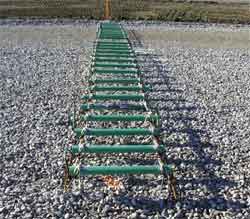Project Details
10/01/03
04/30/06
Federal Highway Administration
Hughes Brothers
Iowa Highway Research Board
Researchers
Max Porter
James K. Cable
Fouad S. Fanous
John Harrington
Nathan Pierson
About the research
Load transfer across transverse joints has always been a factor contributing to the useful life of concrete pavements. For many years, round steel dowels have been the conventional load transfer mechanism. Many problems have been associated with the round steel dowels. The most detrimental effect of the steel dowel is corrosion. Repeated loading over time also damages joints. When a dowel is repeatedly loaded over a long period of time, the high bearing stresses found at the top and bottom edge of a bar erode the surrounding concrete. This oblonging creates multiple problems in the joint.
Over the past decade, Iowa State University has performed extensive research on new dowel shapes and materials to mitigate the effects of oblonging and corrosion. This report evaluates the bearing stress performance of six different dowel bar types subjected to two different shear load laboratory test methods. The first load test is the AASHTO T253 method. The second procedure is an experimental cantilevered dowel test. The major objective was to investigate and improve the current AASHTO T253 test method for determining the modulus of dowel support, k0. The modified AASHTO test procedure was examined alongside an experimental cantilever dowel test. The modified AASHTO specimens were also subjected to a small-scale fatigue test in order to simulate long-term dowel behavior with respect to concrete joint damage. Loss on ignition tests were also performed on the GFRP dowel specimens to determine the resin content percentage.
The study concluded that all of the tested dowel bar shapes and materials were adequate with respect to performance under shear loading. The modified AASHTO method yielded more desirable results than the ones obtained from the cantilever test. The investigators determined that the experimental cantilever test was not a satisfactory test method to replace or verify the AASHTO T253 method.
Project Details
07/22/02
06/30/05
Federal Highway Administration
Hughes Brothers
Researchers
Max Porter
James K. Cable
John Harrington
Anthony Post
Nathan Pierson
About the research
Fiber reinforced polymer (FRP) composite materials are making an entry into the construction market in both buildings and pavements. The application to pavements so far has come in the form of joint reinforcement (dowels and tie bars). FRP resistance to salt corrosion in dowels has made it an alternative to standard epoxy-coated steel dowels for pavements. Iowa State University has completed a large amount of laboratory research to determine the diameter, spacing, and durability of FRP dowels.
This report documents the performance of elliptical FRP dowels installed in a field situation. Ten joints were monitored in three consecutive test sections, for each of three dowel spacings (10, 12, and 15 inches) including one instrumented dowel in each test section. The modulus of dowel bar support was determined using falling weight deflectometer (FWD) testing and a loaded crawl truck. FWD testing was also used to determine load transfer efficiency across the joint. The long-term performance and durability of the concrete was also evaluated by monitoring faulting and joint opening measurements and performing visual distress surveys at each joint. This report also contains similar information for standard round, medium elliptical, and heavy elliptical steel dowels in a portion of the same highway. In addition, this report provides a summary of theoretical analysis used to evaluate joint differential deflection for the dowels.
